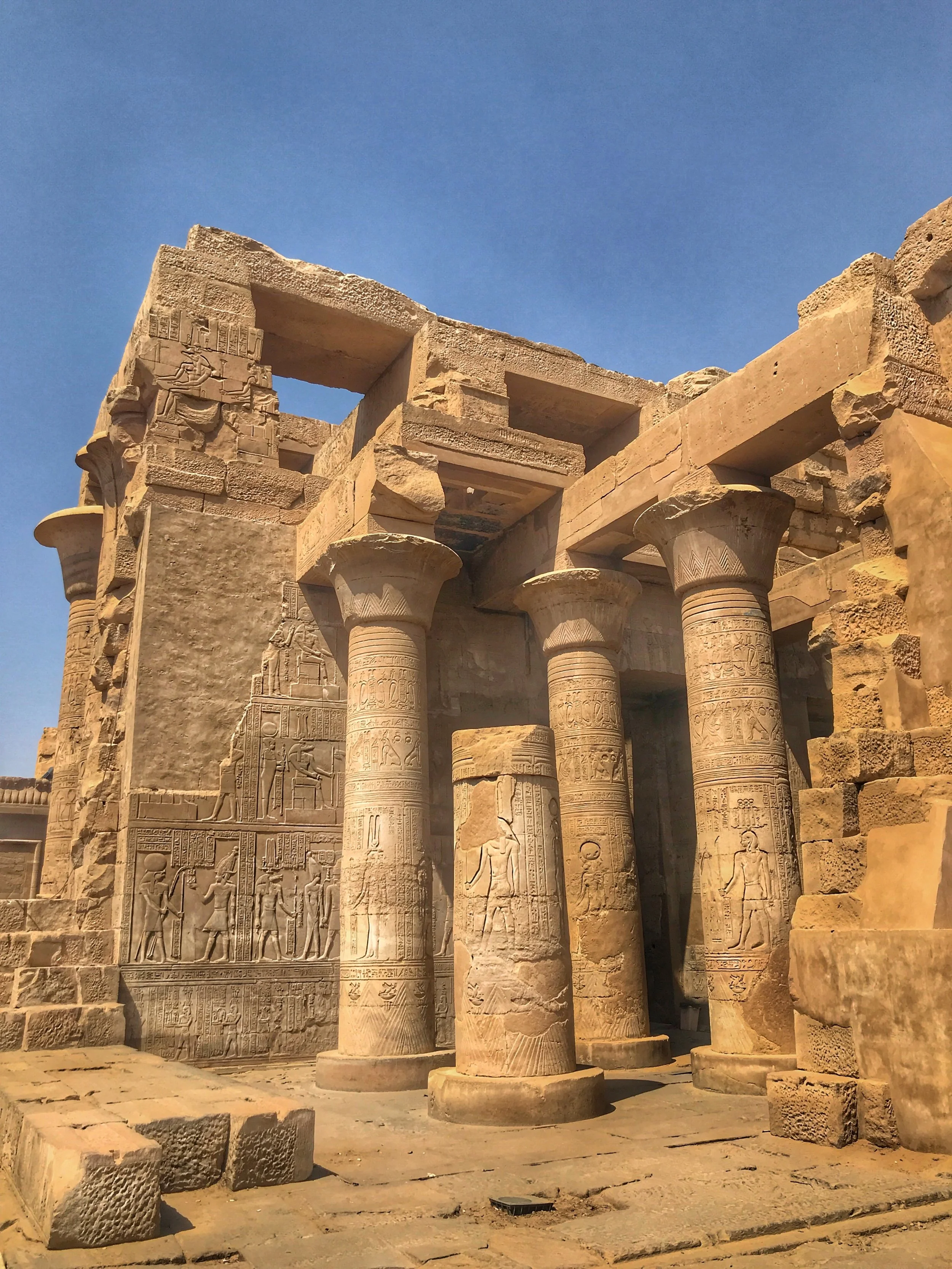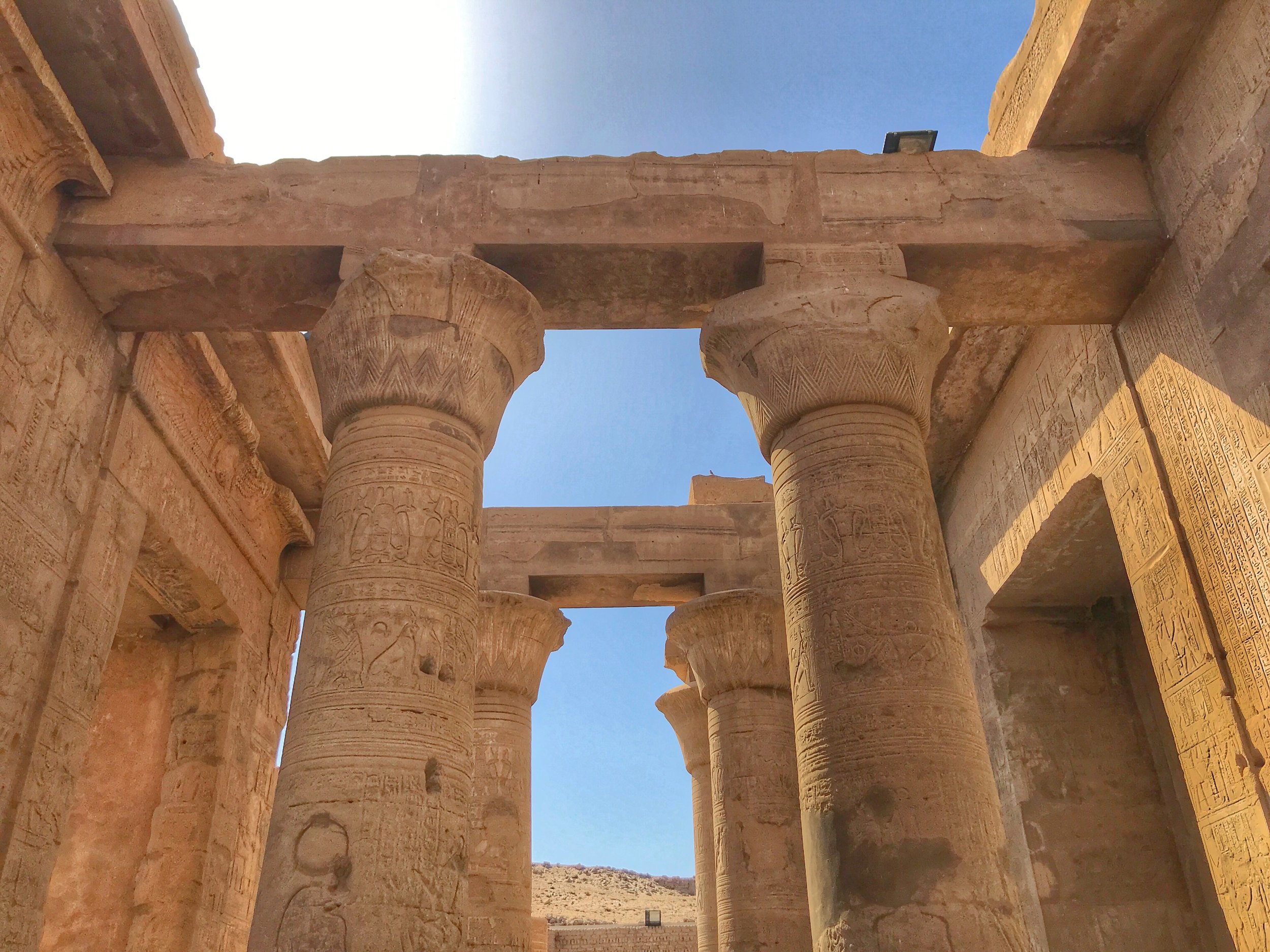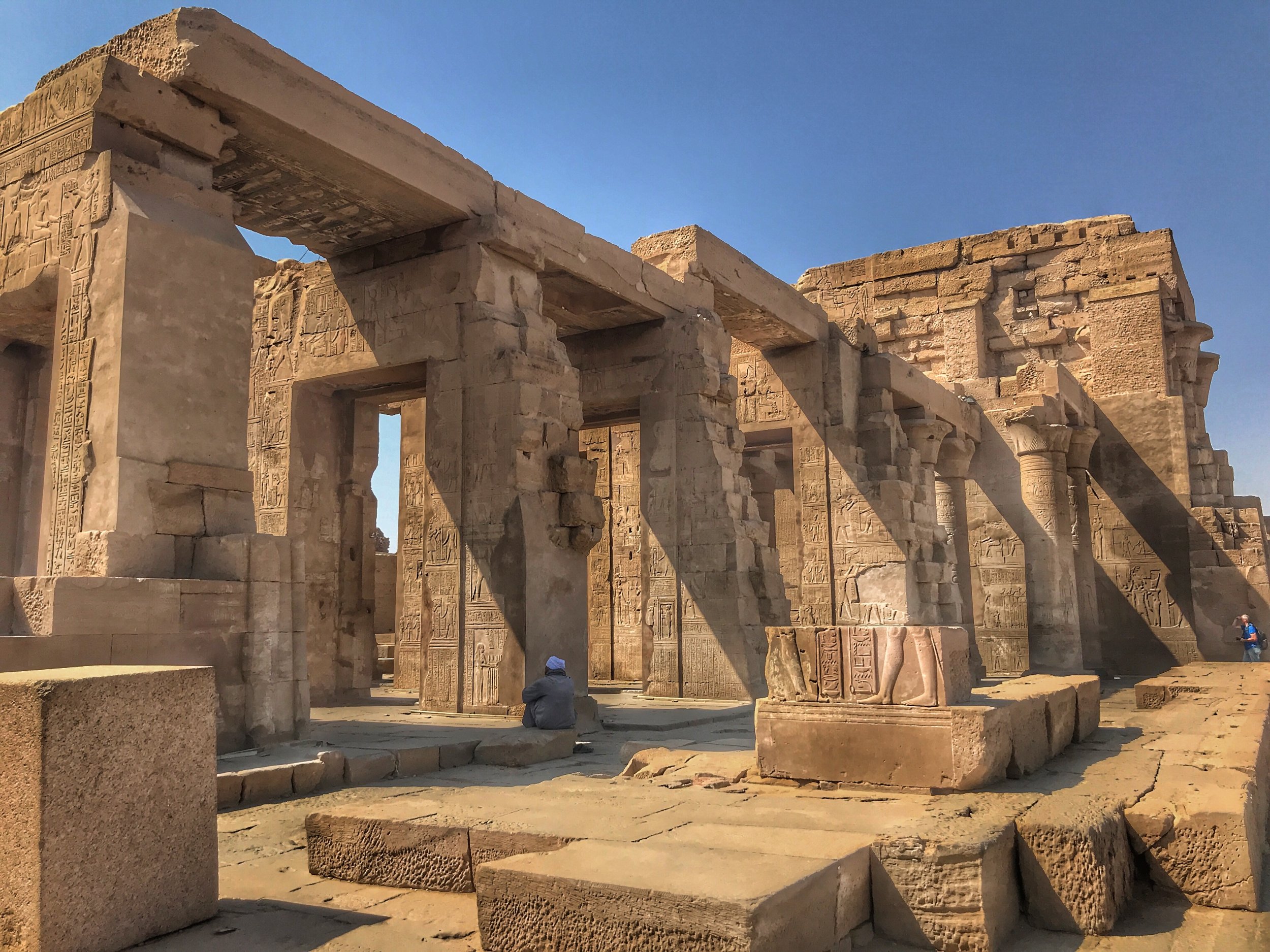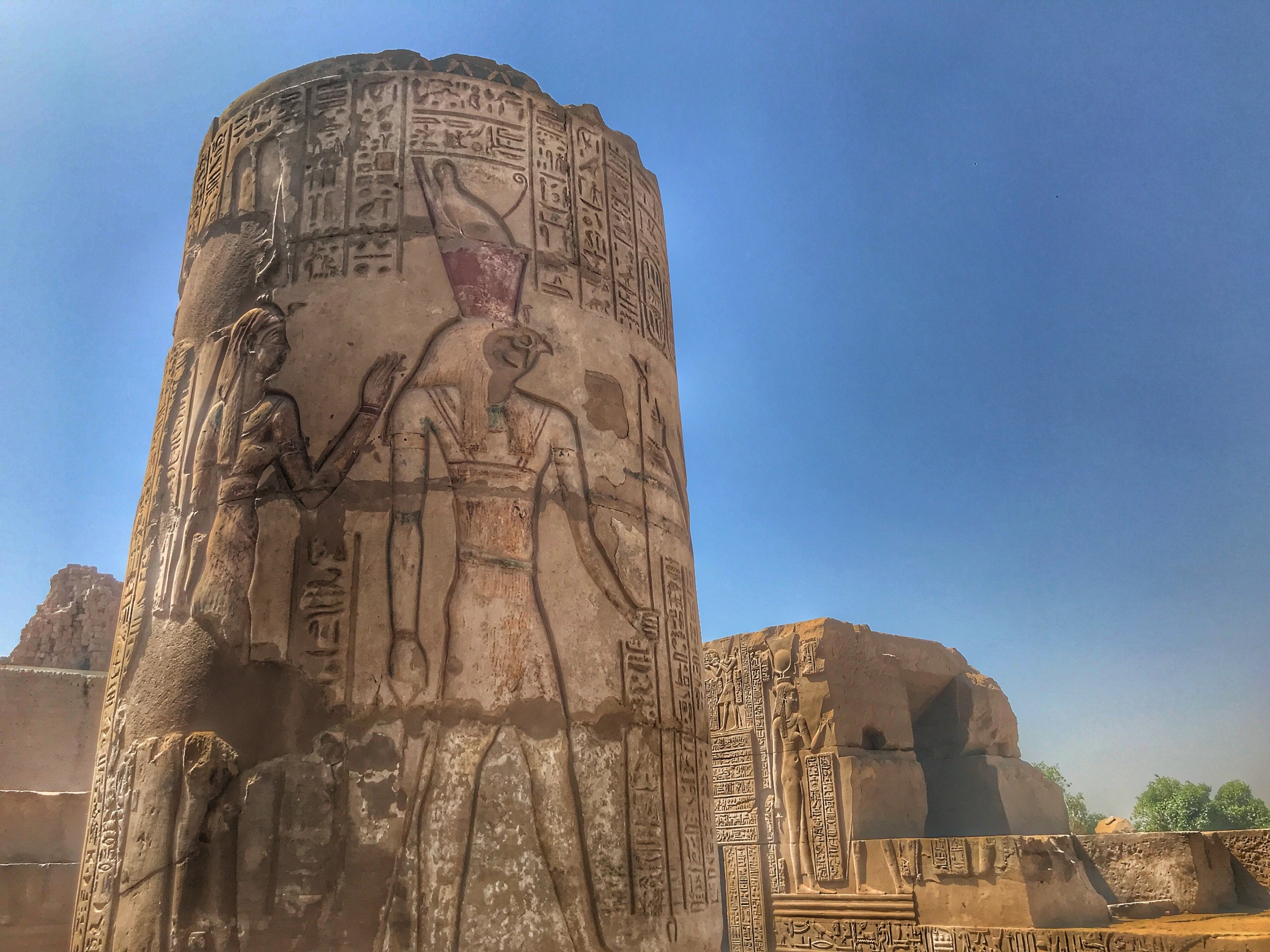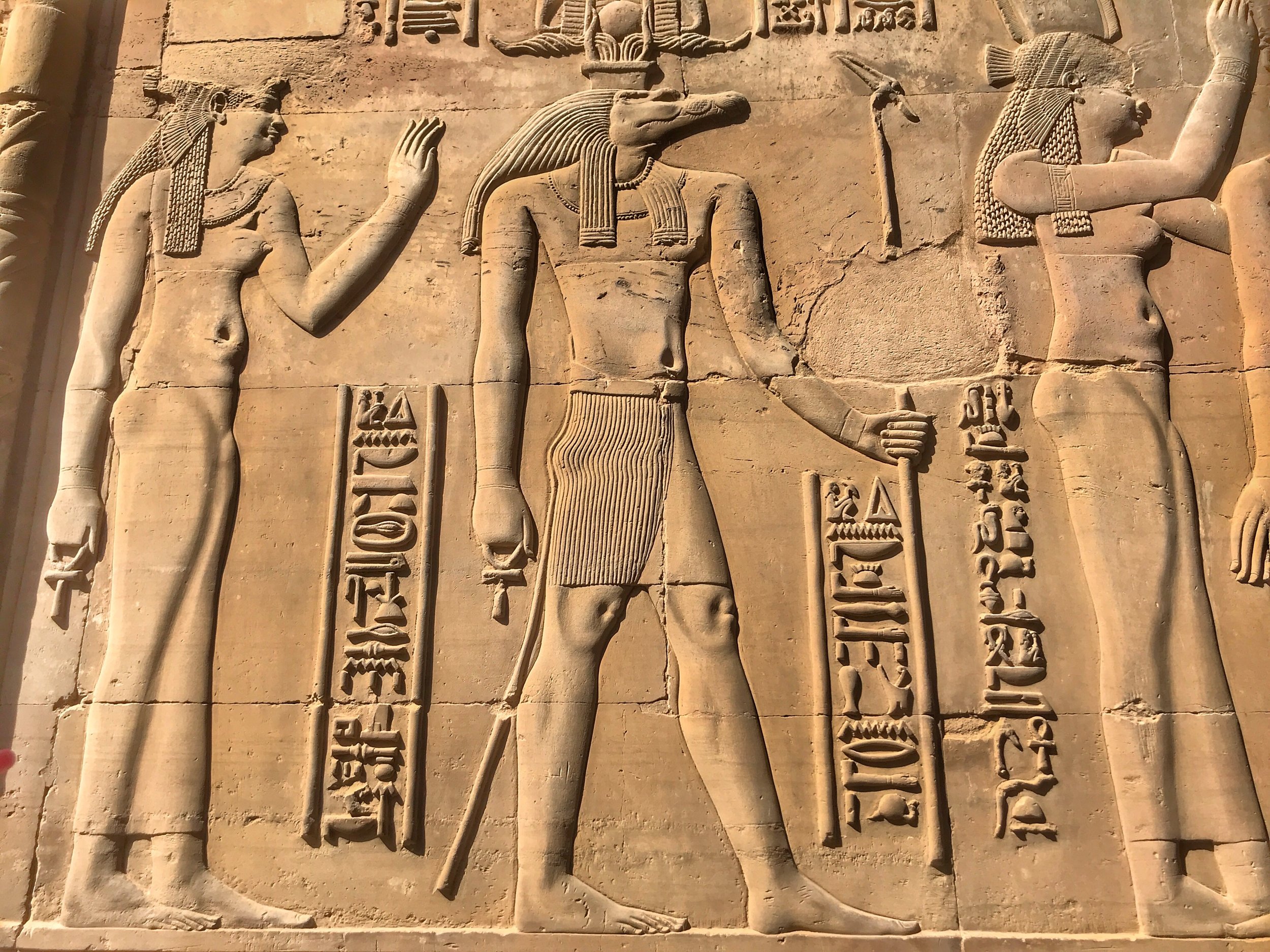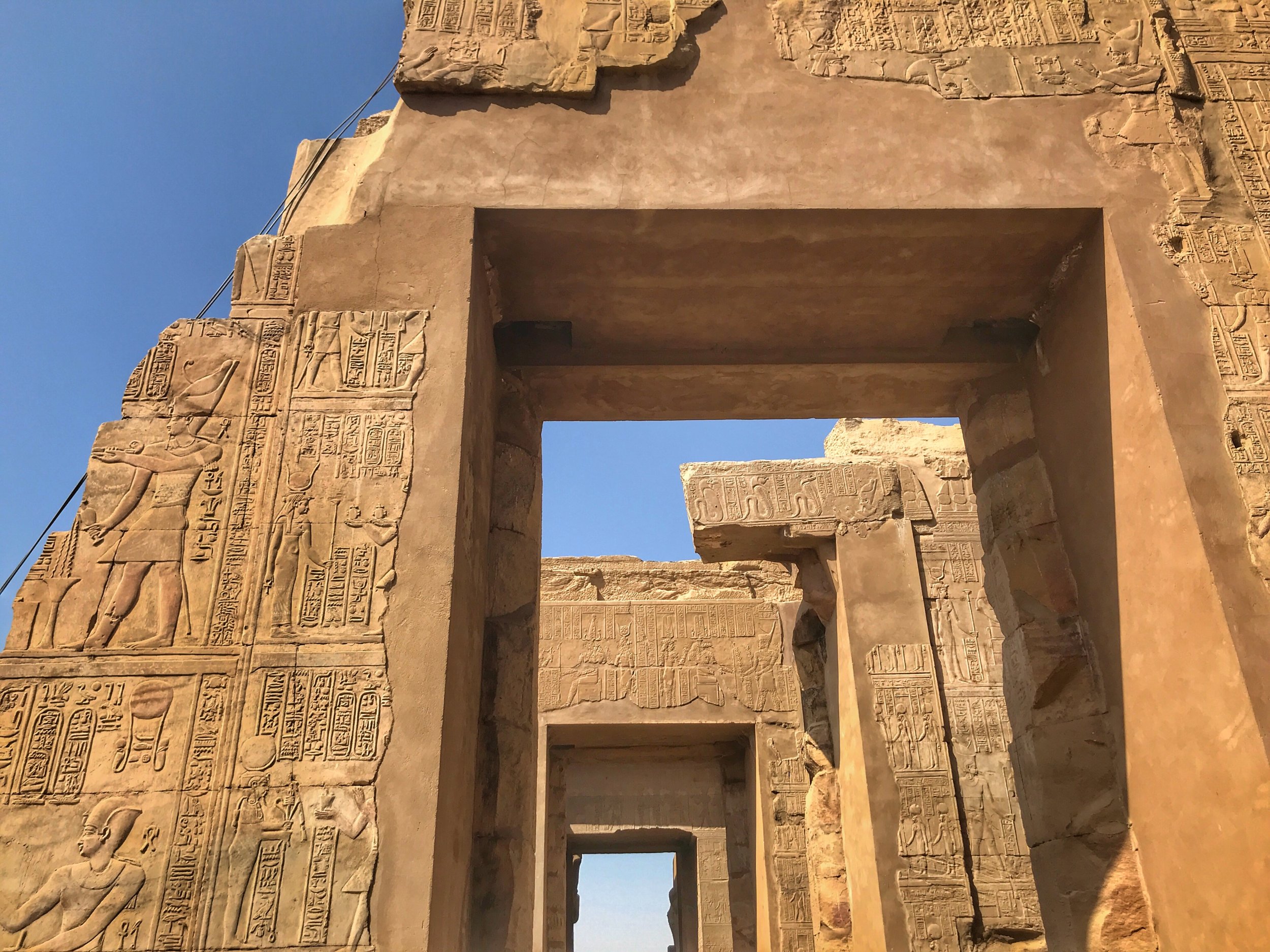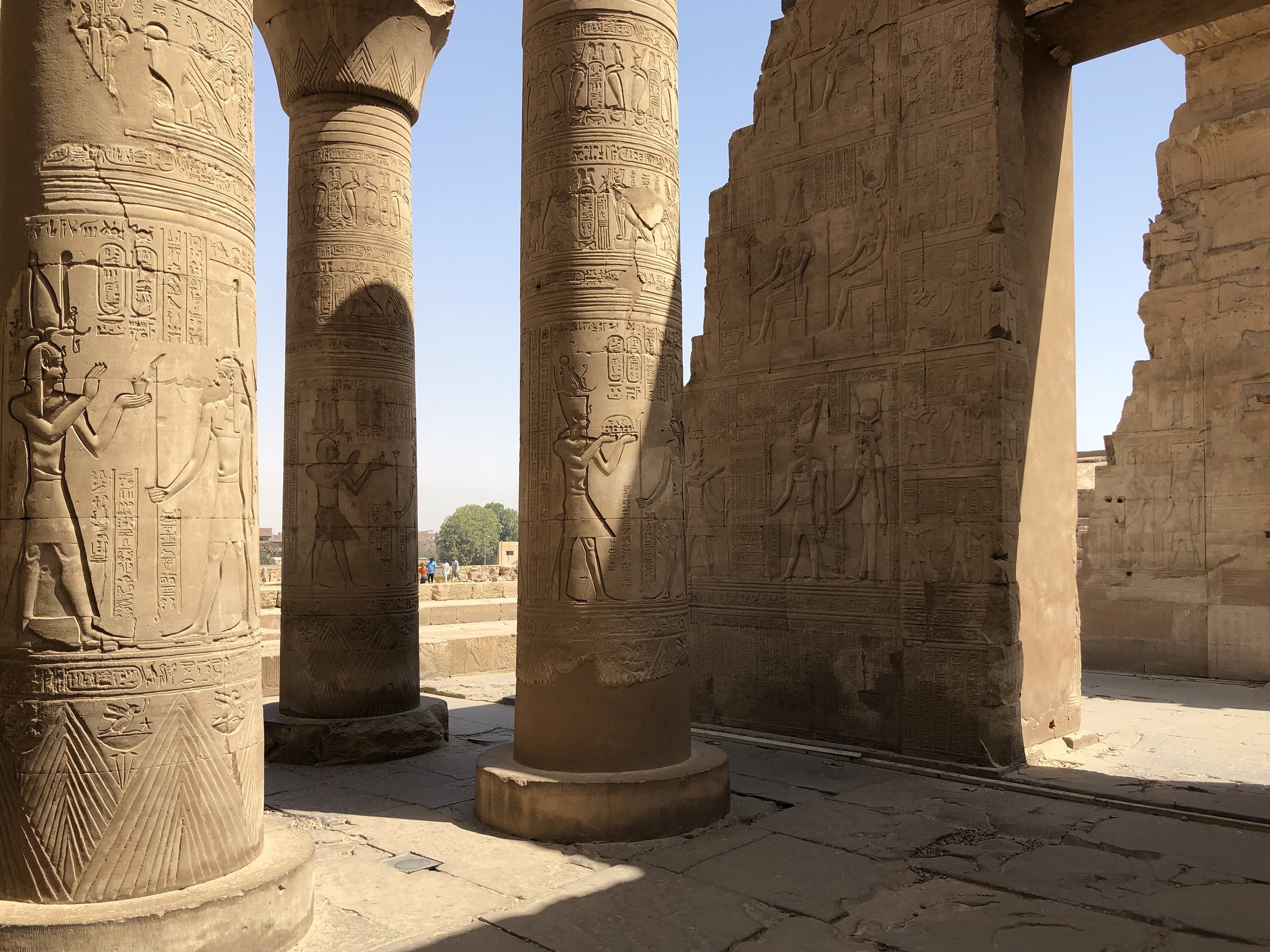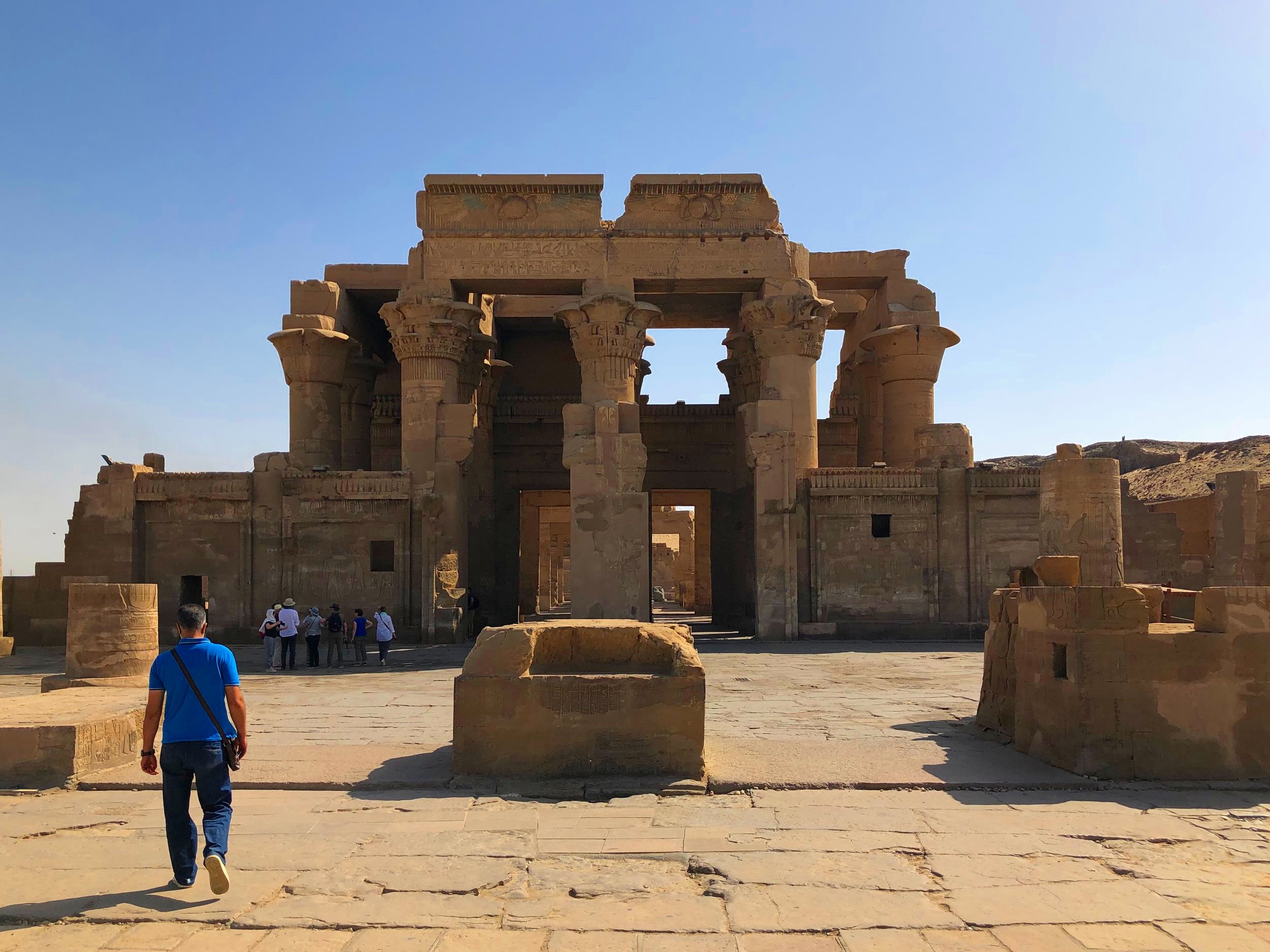Who is the Egyptian crocodile god? Explore a symmetrical ruin and see reptilian mummies at the Crocodile Museum.
Kom Ombo’s distinctive floral flourishes at the top of the columns are what first appealed to Wally
There was something about Kom Ombo that instantly called to me. Perhaps I could sense its Greco-Roman influence. My whole life, I’ve been downright obsessed with Greek myths, and poor Duke has had to watch way too many shows about Ancient Rome.
But, for some reason, I wasn’t that interested in Egypt. That is, not until we decided to visit. Since then, I’ve been devouring books on its vast history and reading its insane mythology. (Case in point: a young god getting buggered by the uncle who killed his father, and then sneakily feeding him his sperm on lettuce leaves — aww, you just have to read it to believe it.)
“Sobek is known as “the raging one” who “takes women from their husbands whenever he wishes, according to his desires.””
These twin temples have been around for a couple of thousands of years
Horus, the falcon-headed god, shares the temple with Sobek, the crocodile god
Duke peeks from behind a column in the forecourt of Kom Ombo
Wally loved exploring this off-the-beaten-path temple
We hired a driver and guide from Egypt Sunset Tours to travel by car from Aswan up to Luxor, stopping at Kom Ombo and Edfu along the way.
Admission to Kom Ombo costs 100 Egyptian pounds, or about $6, and includes the Crocodile Museum next door.
Crocodile-headed Sobek, seen in the middle, is a complicated god of water and fertility
Meet Sobek, the Crocodile God
Part of the appeal of Kom Ombo is its unique setup: It’s actually two temples, divided right down the middle, each a symmetrical mirror of the other. The north side honors Horus, the falcon-headed youthful god of the sun that so many pharaohs associated themselves with; the south is devoted to another figure we didn’t see much in hieroglyphs: Sobek, the local crocodile-headed deity. (His name, in fact, was simply the Ancient Egyptian word for crocodile.)
This part of the Nile, about an hour north of Aswan, was once home to larger numbers of crocodiles. And if there was one thing Nile boaters hated more than hippos, it was crocodiles. Both of these animals made navigating a craft on the river a dangerous prospect. You’ll see quite a few sites with relief carvings of these dangers, though Kom Ombo was the only one we visited that depicted Sobek himself.
Sobek was often depicted as having a crocodile head, ram’s horns and an elaborate crown, as seen on this statue in the Crocodile Museum next to Kom Ombo
Sobek was a complicated figure, swinging back and forth between good and evil.
Sometimes he was associated with Set, the god of chaos whom Horus battled over the rulership of Egypt. Set’s allies turned themselves into crocodiles to escape. In the Pyramid Texts, Sobek is known as “the raging one” who “takes women from their husbands whenever he wishes, according to his desires.”
Then again, some sects believed it was Sobek who created the world, rising out of the dark primordial water to shape the universe. Because he was associated with the River Nile — which flowed from his sweat — and all its life-giving power, Sobek was also a god of fertility.
Pharaohs wanted to imbue themselves with the strength and speed of crocodiles; the hieroglyphic for “sovereign” was a crocodile.
A votive offering from the reign of Amenhotep III
Locals at Kom Ombo believed (hoped?) that if they worshipped crocodiles, treating them as sacred, they would be protected from these ferocious beasts. Many an ancient tomb included a mummified crocodile corpse to extend that protection into the afterlife.
From a safety standpoint, I’m happy to report that nowadays the crocs are long gone. The closest you’ll get to one today are the mummified corpses at the adjacent Crocodile Museum.
Be sure to see the mummified crocs after wandering the ruins of Kom Ombo. Mummies like these were put into tombs so the ferocious beasts could protect the dead in the afterlife
Construction of the temple at Kom Ombo began early during the reign of Ptolemy VI Philometor, about 186 BCE. The hypostyle halls of columns are credited to Ptolemy XIII Theos Philopator, who ruled from 51-47 BCE. And during the Roman period, the Emperor Augustus added the entrance pylon around 30 BCE.
The inner part of the temple is filled with crypts and hidden passageways
With the construction of the Aswan Dam, many Nubians and Sudanese were relocated to the Kom Ombo area
Rocks taken from the temple in 1955 were used to build a local sugar factory!
A temple guard in one of Kom Ombo’s galleries
On one side of the temple’s exterior, a lion bites a hand
Kom Ombo: What’s in a Name?
The name of this temple is undeniably fun to say; it sort of bounces right out of the mouth. It’s interesting in that it’s a mishmash of Arabic and Ancient Egyptian: Kom is Arabic for hill, while Ombo is a corruption of the Egyptian word meaning gold. So Kom Ombo was known as the Hill of Gold.
The site was a popular commercial hub, including, one imagines, for the gold mined down in Nubia to the south.
The Ancient Egyptians were the first to create a 365-day calendar
The Ancient Egyptian Calendar: A Date With Destiny
Those Ancient Egyptians were undeniably clever. In addition to all the architectural marvels you can still tour, they also devised the first 365-day calendar (granted, it started with 360 days, but eventually they figured out they needed to add on five days). There were 12 months of 30 days throughout the three seasons (flooding, growing and harvest, all tied to the annual Nile inundation), with the extra days added to the end of harvest to provide a time for feasting. Of course, the 365-day calendar, which we still use, is flawed, and eventually seasons get off schedule. So Ptolemy III added a day every four years — the beginning of our leap year.
Ancient Egyptians only had three seasons, all tied to the Nile’s flooding and the nutrient-rich soil it left in its wake
Off to the right, as you walk through the temple, there’s a wall of hieroglyphics that show the Egyptian calendar. Our guide, Mamduh (pronounced “Mom-doo”), made a great teacher. He’d show us what certain symbols meant, had us decipher some and would quiz us when the glyph appeared at another location, proud when we got the answer right.
Various rulers of the Ptolemaic dynasty depicted themselves at Kom Ombo
Roman Emperors on Parade
The temple is a bit of a who’s who of Roman emperors. The pylon wall out front shows Domitian wearing the crown of Upper Egypt, while the forecourt colonnade depicts Tiberius making an offering to the local gods. Elsewhere, Horus and the ibis-headed Thoth are pouring holy water over Ptolemy XII, while Sobek looks on. On the other side of the temple, the relief swaps the positions of Sobek and Horus.
Behind this family, you can see Ptolemy XII anointed with holy water by the gods Thoth and Horus
Kom Ombo also houses clinics. A sample treatment was to squeeze onion juice into the eye to treat irritations
Priests would hide in a subterranean tunnel behind the sanctuaries and act as oracles to pilgrims
Notice the dripping penises: Mamduh told us this was a symbol of STDs, which were treated here
Out back, walls rise up in a narrow passageway, depicting not only Emperor Trajan making offerings to the gods but an array of surgical instruments as well.
The temple stands on the banks of the Nile, and teams are now working to protect it from erosion
This well is known as a nilometer and was used to predict Nile floods
Kom Ombo’s Nilometer
Off to the left, if you’re facing the entrance, are the remains of a nilometer, a structure somewhat reminiscent of the stepwells of India, used to predict the flooding of the Nile. I peeked my head over the edge, but even with my feet firmly planted and my body secure on the stone edge, vertigo made my head spin.
Decades of irrigation in what was once the desert have eroded the foundation of Kom Ombo. A U.S.-funded team is working to create a 30-foot-deep trench around the site to divert groundwater back into the Nile.
A large part of Kom Ombo’s appeal is its remoteness. Situated right on the bank of the Nile in a small town miles from Aswan, the site is surrounded by sugarcane fields. In fact, about 50 years ago, before the site was under preservation, a sugarcane magnate pillaged stones from Kom Ombo to build his sugar factory nearby. Can you imagine ancient hieroglyphics mixed in with modern materials to build a factory?! Thank Sobek that Kom Ombo is now under protection, its importance once again realized and respected. –Wally
The symmetry of the temple, half devoted to Sobek, half to Horus, is a large part of Kom Ombo’s appeal
Temple of Kom Ombo
Nagoa Ash Shatb
Markaz Deraw
Aswan Governorate
Egypt
